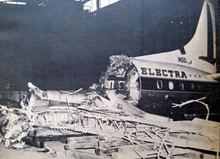Crew 5 Survivors 10 Number of deaths 62 Passenger count 67 | Passengers 67 Fatalities 62 Date 4 October 1960 Injuries (nonfatal) 10 Survivor 10 | |
 | ||
Similar Capital Airlines Flight 20, Austrian Airlines Flight 901, National Airlines Flight 2511, 1960 Munich C‑131 cra, 1960 Danish football ai | ||
Eastern Air Lines Flight 375, registration N5533, was a Lockheed L-188 Electra aircraft that crashed on takeoff from Logan International Airport in Boston, Massachusetts on 4 October 1960. 62 of 72 on board were killed in the accident; ten survived, nine with serious injuries.
N5533 and its crew came into Logan that day as Flight 444 from New York City's LaGuardia Airport. The plane and crew turned around in Boston as Flight 375, which was scheduled to travel to Philadelphia, Pennsylvania, Charlotte, North Carolina and Atlanta, Georgia. The pilots had filed an IFR flight plan that would have had the aircraft cruising to Philadelphia at 10,000 feet. At 5:35 pm, the aircraft pulled away from the terminal and taxied to the threshold of Runway 09 for an easterly departure; the tower cleared it for takeoff at 5:39 PM.
The takeoff was normal until approximately six seconds after liftoff. At that point the aircraft encountered a large flock of starlings. The aircraft veered to the left for a moment then resumed the runway heading. At a height of 200 feet the airplane veered left again and sank nose-up to about 100 feet in altitude. It then rolled to the left, the nose dropped, and the aircraft crashed into Winthrop Bay.
The fuselage broke into two pieces; eight passengers and two flight attendants in the rear section were thrown out of their seats and were quickly picked up by boats already in the bay. The front section sank to the bottom of the bay, taking the majority of the passengers and the flight crew with it. The entire accident sequence from the beginning of takeoff to the impact in the water took less than one minute.
Investigators with the Civil Aeronautics Board (the predecessor of the NTSB) determined that engines Nos. 1, 2, and 4 had each ingested at least one bird, and that engine No. 1 had ingested at least eight. The bird damage caused the No. 1 propeller to autofeather and the engine to shut down at the same time that damage to the No. 2 and No. 4 engines prevented those engines from developing full power at a critical stage of flight. The aircraft, unable to climb, went into a mush. The power interruption to the port engines probably caused the left wing to stall; the wing dropped and the aircraft crashed into the water. There was also evidence that birds had crashed into the windscreen, reducing the pilots' visibility; in addition, bird remains had clogged the pitot tubes, making the pilots' airspeed indicators unreliable.
It was eventually determined that turboprop engines such as those on the Electra were highly sensitive to damage from bird strikes. The CAB recommended to the CAA, the predecessor of the FAA, that steps be taken to reduce the damage caused by bird strikes to turbine engines, and that ways be found to reduce the populations of birds around airports.
However, another possible factor that came to light later was a maintenance defect in the copilot's seat. During civil litigation filed by a family of a deceased passenger, the airplane's maintenance records documented that the adjustable seat had accidentally slid backward during a takeoff about six weeks prior to Flight 375. Rather than perform the proper repair of replacing a metal rod, a mechanic used a strand of wire. A subsequent maintenance check on September 19 showed that the copilot's seat would not lock in any position; it was left in that condition. Expert testimony during the trial claimed that the co-pilot of Flight 375 (who during an emergency would typically be flying the plane while the pilot attempts to locate and solve the problem) most likely pushed the rudder pedal to compensate for unexpected yaw. In doing so, it was surmised that this foot pressure caused the seat to slide backward, which caused him to inadvertently pull back on the yoke. This nose-up condition could have been the decisive stall that caused the final plunge into the water.
